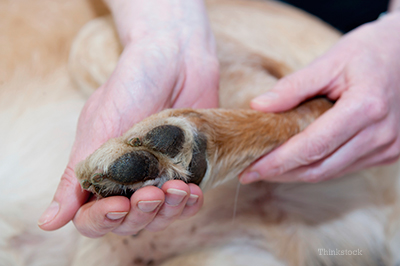
Pododermatitis is an inflammation and/or infection of the foot. It is not a specific disease but rather a descriptive condition that can result from a number of medical problems. Because the prognosis and treatment can vary greatly, depending on the underlying problem, your veterinarian will likely run a thorough checkup to locate the cause. Causes of pododermatitis may include1:
- Allergic dermatitis
- Autoimmune skin disease
- Trauma with a secondary infection (bacterial or fungal)
- Demodicosis
- Neoplasia
Symptoms of pododermatitis
The inflammation may be limited to the feet, with no other areas affected. Unfortunately, inflammation leads to redness and an itchy sensation in the feet. Your dog may start licking and/or chewing his feet, nails and even foot pads.
Excessive licking and chewing may result in secondary infections which cause even more itch, as well as an abnormal odor. Other changes that may occur include:
- A generalized swelling of the feet
- Local swelling of the nodules between the toes
- Development of open and draining tracts (fistulas) with a pus-like or bloody discharge (Draining tracts, will usually lead to scar tissue formation, which makes treatment even more difficult)
Diagnosis of pododermatitis
Your veterinarian will usually begin with two simple tests:
- A skin scraping to look for demodectic mange mites
- A cytology to examine for bacteria and yeast which are common secondary problems
If an allergy is suspected there may be a need for a more complete workup including allergy tests. biopsies and surgical exploration may be required too.
Treatment of pododermatitis
Treatment of pododermatitis is variable because it really depends on the underlying cause. Without question, treatment should be as focused as possible to enhance the results and improve the prognosis for recovery. Combinations of therapy are often required.
Systemic (internal) antibiotics or antifungals can be used to treat secondary infections and may require 3-6 weeks or more of treatment. Topical agents may be used but will usually not afford much improvement on their own and will need to be combined with other drugs2.
Prognosis of pododermatitis
Early and specific treatment will improve the likelihood of a positive outcome for your dog. Chronic inflammation that causes scarring will make the treatment more difficult and increase the likelihood of recurrence.
Prevention of pododermatiis
Regular inspection of the feet is important. It is also helpful to shave the feet between the toes (particularly for long-haired dogs). Prompt veterinary attention is important to prevent chronic damage.
Questions to ask your veterinarian
- My dog’s feet have sores between the toes that drain pus and blood. What could it be?
- What causes draining wounds on my dogs’ feet?
If you have any questions or concerns, you should always visit or call your veterinarian -- they are your best resource to ensure the health and well-being of your pets.
Resources:
- Rees, Christine, DVM, DACVD. "Differential Diagnoses for Canine Pododermatitis (Proceedings)." Dvm.360. 1 Oct. 2008. Web. 19 Jan. 2015. <http%3A%2F%2Fveterinarycalendar.dvm360.com%2Fdifferential-diagnoses-canine-pododermatitis-proceedings%3Frel%3Dcanonical>.
- "Pododermatitis." Dermatology for Animals. Web. 19 Jan. 2015. <http://www.dermatologyforanimals.com/faq-38/>.
